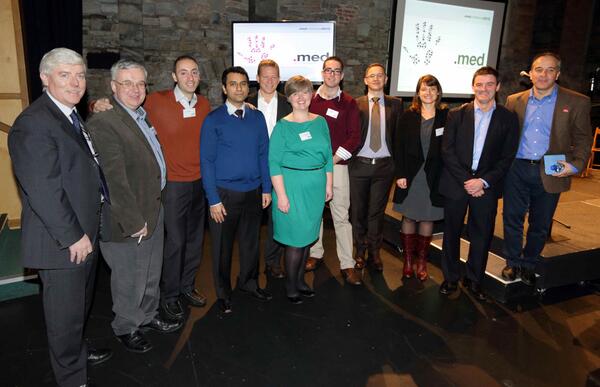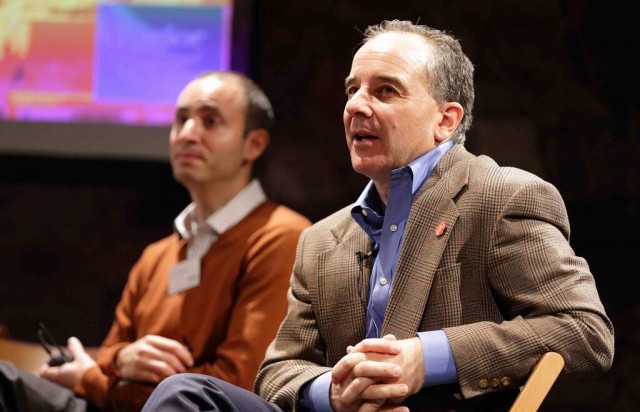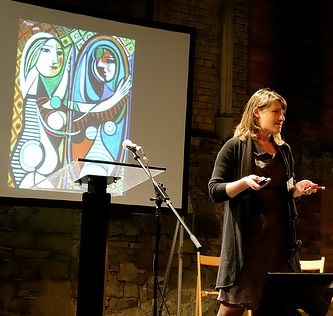Last week, I was fortunate to present a workshop at the second annual DOTmed, a Dublin-based healthcare innovation conference like no other. DOTmed follows a fierce curiosity on the future of healthcare, with priorities rigorously routed in the innermost realities of the human condition. Organized by Drs. Ronan Kavanagh and Muiris Houston, DOTmed mixed a stiff cocktail of technology, story and art going straight to medicine’s core heartbeat and its reverberations into the future.
Here’s what’s stayed with me since that transformative day:
1. The biggest factor in health and success just may be luck. Ed Gavagan’s story hit this home. I highly recommend his TED talk; we were lucky enough to get a longer version as well as an electrifying Q&A session with him. Rarely do we acknowledge that it’s just luck behind the cards we’re dealt, and they can change at any time. Sure, it’s important to focus on the things we can control through strategy and hard work, but it’s a delusion (and one of privilege) not to see the scary truth about luck. Ed’s story shakes us awake to the point where there is no choice but to look. And, because luck plays out all the time in healthcare, with big ramifications on human outcomes and vast injustices… we gotta look.
Drs. Bryan Vartabedian (front) and Jordan Grumet
2. The leading technologists may rattle the traditionalists but they are actually all on the same side. DOTmed began with a talk by medical futurist (aka “geek medical doctor with a PhD in genomics”) Bertalan Mesko, covering some of his broadly-scaled offerings that educate people on all sides of interactions in healthcare on how to make effective use of technology and widely-available information. Berci confessed a lifelong love of gadgets, but don’t be fooled – that’s not what it’s about. “The real challenge in medicine,” he said, “is to preserve the human art while leveraging technology.” Many leading technologists and “futurists,” echo similar sentiments (such as Eric Topol in his recent blockbuster book). Many of us in the fields with strong roots to humanities, like arts and letters and museums (and medicine, too), expect the opposite of technologists–and too often close off to futuristic conversations. But we need to come to the table here, because there is great uncertainty as to what it will mean and the humanities have a real voice to contribute to the big picture.
3. The dinosaur of academic medicine and the dragon of social media are learning to be friends. The conflict between old ways of doing things and new technology is as old as the ages. In medicine, that conflict is alive and well. What really hit this home for me was when trainee Mahmood Mirza (in a presentation with Dr. Alan Corbett) cited a study that 17% of US program directors use social media to check job applicants, and 33% of the time rated them lower as a result. Yet DOTmed left me feeling hopeful that, in medicine, this conflict is on the road to becoming less of a fight and more of a dynamic and valuable interaction. I credit this sense of hope to the range of uses of social media—all of them connecting the dots between careful, ethical professionalism and public engagement—featured at DOTmed: Dr. Jordan Grumet’s brutally honest tales of life as a careprovider, Dr. Anne Marie Cunninham’s innovations connecting the right patients with the right medical practitioners and learners, and Dr. Bryan Vartabedian’s leadership and teaching in public health communication. Bryan’s discussions of two cases in particular, Buckyballs (a magnetic toy that was frequently swallowed by children, causing life-threatening internal damage) and Andrew Wakefield’s fraudulent misinformation on MMR and autism, showed how savvy clinicians were able to use social media to set the record straight and make effective changes to policy and to public health behavior (especially around parenting). With each project, all three of these individuals are turning widespread pessimism towards social media into authentic curiosity. Interestingly, all of them emphasized that the real nectar of Twitter is not about getting a billion followers but making the right connections and getting the best information the fastest.
4. Embracing pain is the fundamental work of healing – perhaps the most important learning trajectory of all of our lives. Jordan’s talk hit this out of the park. Read his blog; there is some profoundly honest stuff in there, casting insight into all aspects of healthcare. Jordan does not let taboo prevent him from telling the truth. Learning to embrace pain, to be more honest and real and effective with patients, is an untaught skill – and until we learn to deal with this, physician burnout will remain a massive cost.
In Smock Alley Theater, seated in modernist pews inclining on a steep nod to Elizabethan audiences, I couldn’t help but see each presenter as an actor doing his part to perform one reality of this complex beast of healthcare. Each part was essential. DOTmed acknowledged, in its unique program design, that healthcare encompasses all aspects of humanity. The result was a serious conversation about the future performed with humanistic awakeness in the present. I was honored to be a part of its second convening will be watching this conference and its growing community of actors for years to come.
When videos of the Dotmed talks are available, I will post them here – so check back.
Talking about art (Picasso’s Girl Before a Mirror). Photo by Anne Marie Cunningham
Here are some of the other round-ups on DOTmed:
- Jordan Grumet’s synopsis
- Bryan Vartabedian’s take
- June Shannon’s analysis in the Irish Times
- Stream of tweets
- Anne Marie Cunningham’s post as well as her wonderful photostream




